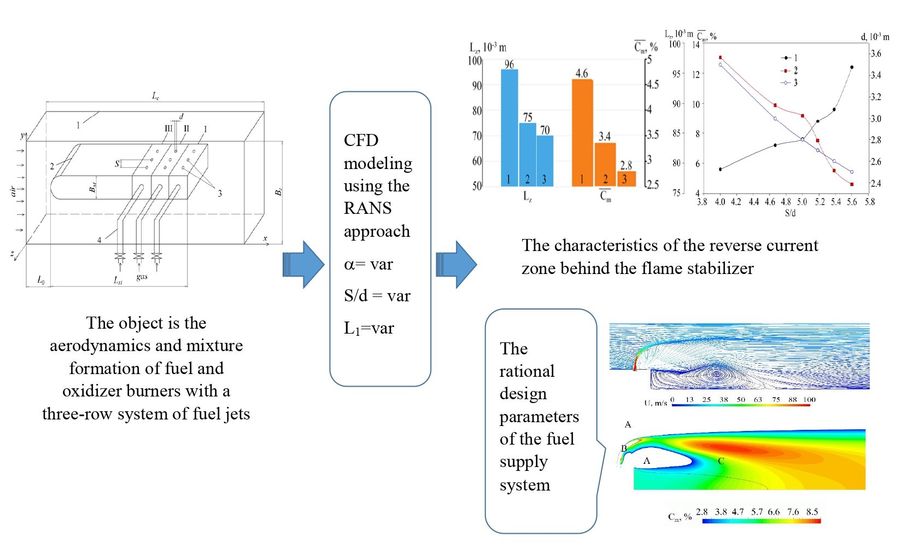Встановлення закономірностей ізотермічної течії та сумішоутворення у мікрофакельних пальниках з трирядною струменевою подачею палива
DOI:
https://doi.org/10.15587/1729-4061.2022.267891Ключові слова:
мікрофакельні пальники, структура течії, сумішоутворення палива та окиснювача, струменева паливоподачаАнотація
Об’єктом досліджень є аеродинаміка та сумішоутворення палива та окиснювача у пальниках стабілізаторного типу з трирядною системою паливних струменів, орієнтованих на експлуатацію при коефіцієнтах надлишку повітря 1,1…1,5. Дослідження проведено на основі CFD моделювання з використанням RANS (Reynolds Averaged Navier-Stokes) підходу.
Виконано аналіз основних закономірностей протікання зазначених процесів у мікрофакельних пальниках, що пропонуються. При цьому особливу увагу приділено розгляду характеристик течії та сумішоутворення у закормовій області стабілізатора полум'я, де формуються вихрові структури, що відповідають за стабілізацію факелу.
Досліджено закономірності впливу на течію і сумішоутворення в пропонованих пальникових пристроях таких факторів, як номер ряду NR струменевої подачі палива, відносний крок S/d розташування газоподавальних отворів і коефіцієнт надлишку повітря α. Встановлено наявність помітних відмінностей у структурі течії та сумішоутворення в пальниках при паливоподачі в різні ряди газоподавальних отворів. Показано, що аеродинаміка і картина змішування палива і окиснювача зазнають суттєвих змін при варіюванні величини S/d.
Для розглянутих пальникових пристроїв визначено раціональні конструктивні параметри системи подачі палива, при яких забезпечуються сприятливі умови сумішоутворення в області стабілізації полум'я. Зокрема показано, що раціональні значення S/d становлять 5,4; 5,6 і 5,8 відповідно для першої, другої і третьої секції паливовоподачі.
Отримані результати можуть широко використовуватися в енергетичній практиці для об'єктів, що експлуатуються за умов змінних значень коефіцієнта надлишку повітря
Посилання
- Warnatz, J., Maas, U., Dibble, R. W. (2003). Combustion. Physical and Chemical Fundamentals, Modeling and Simulation, Experiments, Pollutant Formation. Springer, 299. doi: https://doi.org/10.1007/978-3-662-04508-4
- Tran, A., Aguirre, A., Durand, H., Crose, M., Christofides, P. D. (2017). CFD modeling of a industrial-scale steam methane reforming furnace. Chemical Engineering Science, 171, 576–598. doi: https://doi.org/10.1016/j.ces.2017.06.001
- Gianetti, G., Sforza, L., Lucchini, T., D’Errico, G., Soltic, P., Rojewski, J., Hardy, G. (2019). CFD modeling of natural gas engine combustion with a flame area evolution model. AIP Conference Proceedings. doi: https://doi.org/10.1063/1.5138820
- van Oijen, J. A., Donini, A., Bastiaans, R. J. M., ten Thije Boonkkamp, J. H. M., de Goey, L. P. H. (2016). State-of-the-art in premixed combustion modeling using flamelet generated manifolds. Progress in Energy and Combustion Science, 57, 30–74. doi: https://doi.org/10.1016/j.pecs.2016.07.001
- Perpignan, A. A. V., Talboom, M. G., Levy, Y., Rao, A. G. (2018). Emission Modeling of an Interturbine Burner Based on Flameless Combustion. Energy & Fuels, 32 (1), 822–838. doi: https://doi.org/10.1021/acs.energyfuels.7b02473
- Hosseini, S. E., Wahid, M. A. (2014). Investigation of bluff-body micro-flameless combustion. Energy Conversion and Management, 88, 120–128. doi: https://doi.org/10.1016/j.enconman.2014.08.023
- Askarova, A. S., Messerle, V. E., Bolegenova, S. A., Maksimov, V. Yu., Bolegenova, S. A., Nugymanova, A. O. (2022). Influence of the method of air-fuel mixture supply on the main characteristics of heat and mass transfer processes. Thermophysics and Aeromechanics, 29 (1), 107–124. doi: https://doi.org/10.1134/s0869864322010097
- Stefanizzi, M., Stefanizzi, S., Ceglie, V., Capurso, T., Torresi, M., Camporeale, S. M. (2021). Analysis of the partially premixed combustion in a labscale swirl-stabilized burner fueled by a methane-hydrogen mixture. E3S Web of Conferences, 312, 11004. doi: https://doi.org/10.1051/e3sconf/202131211004
- Fialko, N., Prokopov, V., Sherenkovskii, J., Aleshko, S., Meranova, N. (2021). Influence of the primary and secondary air consumption ratio on the microjet burner devices efficiency. Chap. 10.2. Technical research and development. Boston, 430–434. Available at: https://isg-konf.com/wp-content/uploads/2021/04/Monograph-USA-Technical-2021-I-isg-konf.pdf
- Fialko, N., Prokopov, V., Sherenkovskiy, J., Tymoshchenko, O., Polozenko, N., Kutnyak, O. et al. (2020). Analysis of the possibilities of regulating the process of mixture formation in microjet burners with cylindrical flame stabilizers. International Scientific Journal “Internauka,” 12. doi: https://doi.org/10.25313/2520-2057-2020-12-6215
- Jones, W. P., Marquis, A. J., Wang, F. (2015). Large eddy simulation of a premixed propane turbulent bluff body flame using the Eulerian stochastic field method. Fuel, 140, 514–525. doi: https://doi.org/10.1016/j.fuel.2014.06.050

##submission.downloads##
Опубліковано
Як цитувати
Номер
Розділ
Ліцензія
Авторське право (c) 2022 Nataliia Fialko, Nataliia Meranova, Julii Sherenkovskii, Sergey Aleshko, Michael Abdulin, Vitalii Babak, Volodymyr Korzhyk, Vasyl Zhelykh, Roman Dinzhos, Vladyslav Khaskin

Ця робота ліцензується відповідно до Creative Commons Attribution 4.0 International License.
Закріплення та умови передачі авторських прав (ідентифікація авторства) здійснюється у Ліцензійному договорі. Зокрема, автори залишають за собою право на авторство свого рукопису та передають журналу право першої публікації цієї роботи на умовах ліцензії Creative Commons CC BY. При цьому вони мають право укладати самостійно додаткові угоди, що стосуються неексклюзивного поширення роботи у тому вигляді, в якому вона була опублікована цим журналом, але за умови збереження посилання на першу публікацію статті в цьому журналі.
Ліцензійний договір – це документ, в якому автор гарантує, що володіє усіма авторськими правами на твір (рукопис, статтю, тощо).
Автори, підписуючи Ліцензійний договір з ПП «ТЕХНОЛОГІЧНИЙ ЦЕНТР», мають усі права на подальше використання свого твору за умови посилання на наше видання, в якому твір опублікований. Відповідно до умов Ліцензійного договору, Видавець ПП «ТЕХНОЛОГІЧНИЙ ЦЕНТР» не забирає ваші авторські права та отримує від авторів дозвіл на використання та розповсюдження публікації через світові наукові ресурси (власні електронні ресурси, наукометричні бази даних, репозитарії, бібліотеки тощо).
За відсутності підписаного Ліцензійного договору або за відсутністю вказаних в цьому договорі ідентифікаторів, що дають змогу ідентифікувати особу автора, редакція не має права працювати з рукописом.
Важливо пам’ятати, що існує і інший тип угоди між авторами та видавцями – коли авторські права передаються від авторів до видавця. В такому разі автори втрачають права власності на свій твір та не можуть його використовувати в будь-який спосіб.










